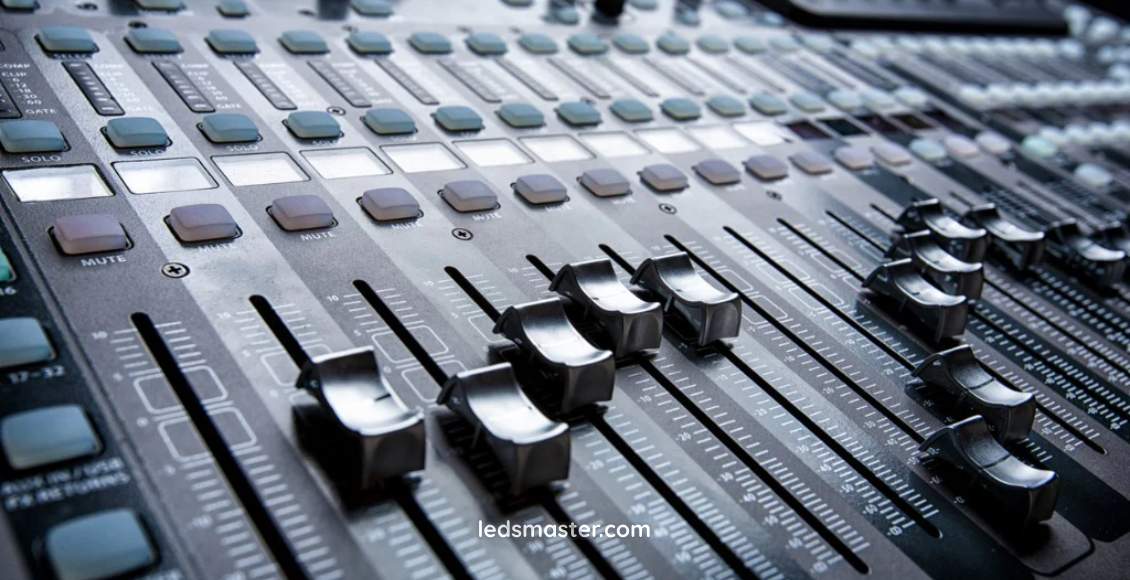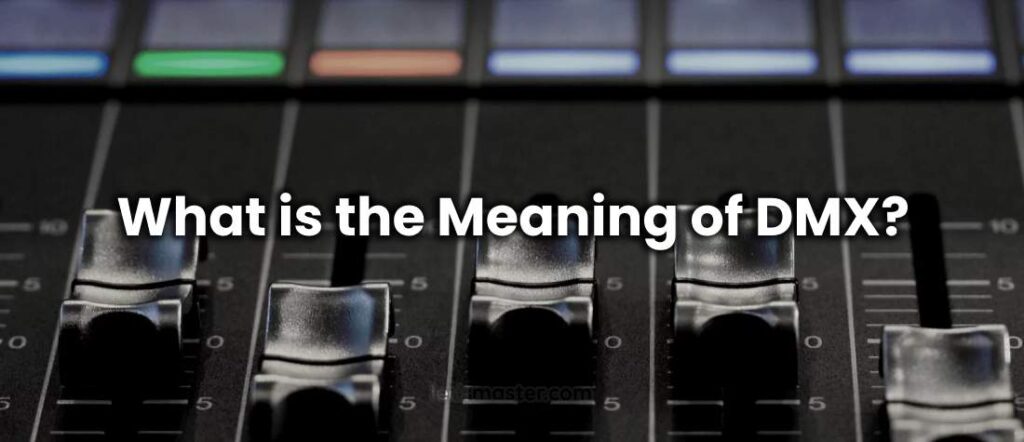Digital Multiplex (DMX) is a protocol widely used in the world of lighting control, essential for managing and synchronizing multiple lighting fixtures from a single control point. This communication standard, originally developed for stage lighting, has become a cornerstone of modern lighting systems. Its ability to control various devices through a unified system makes it indispensable in both entertainment and architectural lighting applications. This article explores the meaning of DMX and its significance, particularly in relation to LED lighting technology.
Table of Contents
ToggleHow DMX Works
DMX operates through a serial communication protocol that sends data to control lighting fixtures and other effects. The “512” in DMX-512 refers to the maximum number of channels that can be addressed by a single DMX network. Each channel controls a specific parameter, such as brightness or color, allowing for detailed and precise manipulation of lighting fixtures. A DMX controller transmits data packets over a single cable to connected devices, which interpret and act upon these commands.
The system is designed for flexibility and scalability, enabling users to control a vast array of fixtures with varying functionalities. By addressing each fixture or device individually, DMX ensures that complex lighting setups can be managed efficiently and accurately.

DMX and LED Lighting
Integration of DMX with LED Technology
The integration of DMX (Digital Multiplex) with LED (Light Emitting Diode) lighting systems has brought a profound enhancement to modern lighting design, thanks to its ability to provide advanced and highly precise control over various lighting parameters. LEDs are celebrated for their energy efficiency, long lifespan, and minimal maintenance needs, making them an excellent choice for a range of applications. When paired with DMX control, LEDs gain the ability to execute sophisticated lighting features such as dynamic color changing, smooth dimming, and complex effects like strobing and pulsing. This synergy allows lighting designers to craft intricate and visually captivating displays, whether for theatrical productions, concerts, architectural highlights, or special events. The real-time adjustment capabilities and programmable sequences of DMX-controlled LEDs enable the creation of tailored lighting experiences that enhance both the aesthetic appeal and functional aspects of any environment.
In practical applications, this combination proves invaluable for achieving precise and synchronized lighting effects. For instance, in stage productions, the accurate color matching and effect synchronization made possible by DMX control ensure that lighting complements set designs, costumes, and performance elements seamlessly, enhancing the overall visual impact and audience experience. Similarly, in architectural lighting, DMX-controlled LEDs allow designers to implement sophisticated color schemes and dynamic lighting patterns that can highlight architectural features and respond to various events or environmental conditions. This versatility extends to commercial and event settings as well, where the flexibility to adjust lighting in real-time helps create engaging atmospheres and memorable experiences. Thus, DMX and LED integration represents a significant advancement in lighting technology, offering unparalleled control and creative potential for diverse lighting applications.
Advantages of Using DMX with LEDs
One of the primary advantages of integrating DMX (Digital Multiplex) with LED (Light Emitting Diode) lighting is its ability to deliver complex and highly customized lighting effects. DMX controllers provide a sophisticated interface that allows users to program and execute intricate lighting scenes, transitions, and effects with precision. This capability is particularly valuable in environments where creating immersive and dynamic visual experiences is crucial. For theatrical performances, concerts, or architectural lighting projects, DMX enables designers to orchestrate detailed lighting arrangements that synchronize with various elements, such as music, stage movements, or architectural features. This level of control not only enhances the visual impact but also ensures that every lighting detail aligns perfectly with the creative vision, making it an indispensable tool for achieving professional-grade lighting designs.
Moreover, DMX control streamlines the management of LED lighting systems by consolidating control into a single, centralized interface. This centralization allows lighting designers to establish pre-programmed sequences and make real-time adjustments with ease. By using DMX controllers, designers can quickly modify lighting settings during an event or performance, ensuring that illumination remains consistent and accurate throughout. This flexibility is particularly beneficial for live events where lighting needs to adapt to changing conditions or for architectural installations where continuous and precise illumination is required. Overall, DMX control simplifies the operation of LED lighting systems, enabling designers to maintain a high level of precision and consistency while enhancing their ability to create dynamic and engaging visual experiences.
Ensuring Compatibility
Integrating DMX with LED lighting systems can present several challenges, one of which is ensuring compatibility between DMX controllers and LED fixtures. Although DMX-512 is a standardized protocol, variations in its implementation across different manufacturers can lead to compatibility issues. This means that not all DMX controllers and LED fixtures are guaranteed to work seamlessly together. It is crucial to carefully select components that are verified to be compatible with each other and to ensure proper system configuration to avoid potential conflicts. Ensuring that all components adhere to the same DMX standards and protocols can help in achieving a reliable and functional lighting setup.
Addressing Signal Interference
Another significant challenge is addressing potential interference and signal degradation. DMX signals can be susceptible to various factors, including cable length, environmental conditions, and electrical noise, all of which can impact the reliability of communication between the DMX controller and the LED fixtures. Longer cable runs, in particular, can lead to signal loss or degradation, which may result in inconsistent lighting performance. To mitigate these issues, it is important to implement proper cabling practices, such as using high-quality cables and connectors, and to consider the use of signal boosters if necessary. Adhering to industry standards and best practices for DMX installation can help maintain stable and reliable performance, ensuring that the lighting system operates as intended.
Applications of DMX-Controlled LED Lighting
Entertainment and Performance Lighting
In the entertainment industry, DMX-controlled LED lighting plays a pivotal role in creating captivating visual experiences. Stage lighting for concerts, theater productions, and live events relies heavily on DMX to achieve synchronized lighting effects and dynamic color changes. The ability to control multiple LED fixtures simultaneously allows for seamless transitions and complex lighting designs that enhance the overall performance.
Architectural and Urban Lighting
Architects and urban planners use DMX-controlled LED lighting to create visually impactful and functional lighting designs. In architectural applications, DMX allows for the precise control of LED lights used to illuminate building facades, highlight architectural features, and create dynamic lighting schemes. This capability enables designers to craft visually appealing and functional lighting solutions that enhance the aesthetic and functional aspects of buildings and public spaces.
Commercial and Retail Spaces
In commercial and retail environments, DMX-controlled LED lighting can be used to create inviting and engaging atmospheres. For example, retail stores often use dynamic lighting displays to attract customers and highlight merchandise. DMX control allows for the adjustment of lighting intensity, color, and effects to match promotional events, seasonal themes, or specific store layouts.
Event and Exhibit Lighting
Events such as exhibitions, trade shows, and festivals benefit from the flexibility of DMX-controlled LED lighting. The ability to quickly adjust lighting settings and create dynamic effects helps in setting the desired mood and emphasizing key elements of the event. Whether it’s for trade show booths, exhibition displays, or outdoor festivals, DMX control enhances the visual impact and overall experience for attendees.
DMX System Components
DMX Controllers
DMX controllers are the central component of a DMX lighting system. These devices send control signals to the connected lighting fixtures, allowing users to manage and program various lighting parameters. Controllers come in various forms, from basic handheld units to advanced software-based systems that offer extensive programming capabilities.
DMX Decoders
DMX decoders are used to convert DMX signals into control signals that can be understood by LED fixtures. They act as intermediaries between the DMX controller and the LED lights, ensuring that the commands are correctly interpreted and executed. Decoders are essential for managing complex lighting setups that involve multiple LED fixtures.
DMX Cables and Connectors
The reliability of a DMX lighting system depends on the quality of its cables and connectors. DMX cables transmit control signals from the controller to the fixtures, and using high-quality cables helps minimize signal interference and degradation. Connectors ensure a secure and stable connection between components, which is crucial for maintaining consistent performance in a DMX network.
Conclusion
DMX (Digital Multiplex) has become an essential protocol in the realm of lighting control, revolutionizing the way multiple lighting fixtures are managed and synchronized from a single control point. Its application in LED (Light Emitting Diode) lighting systems enhances both functionality and creative potential, allowing for sophisticated effects such as dynamic color changes, smooth dimming, and intricate lighting sequences. This integration not only improves the precision and versatility of lighting designs in various settings—such as theatrical productions, architectural features, and events—but also simplifies the management of complex lighting setups through centralized control. While challenges such as ensuring compatibility and addressing signal interference can arise, the benefits of combining DMX with LED technology are substantial, offering unparalleled control and adaptability to create visually striking and memorable lighting experiences.

